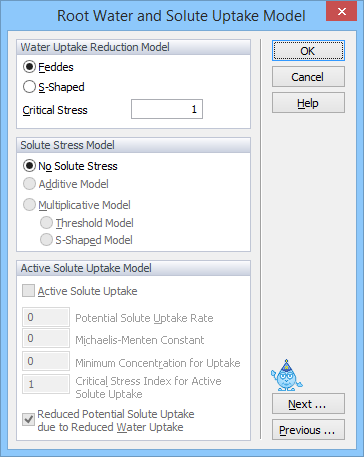1. Root Water Uptake Model
The Water Uptake Reduction Model and Solute Stress Model are selected in the Root Water Uptake Model dialog window.

a. Pressure Head Reduction Model
The water stress response function suggested by Feddes et al. [1978] and an S-shaped function suggested by van Genuchten [1985] can be used to reduce the potential root water uptake to actual root water uptake. Root water uptake with compensation can be simulated when the Critical Stress Index is smaller than one (see the Technical Manual, Šimunek et al. [2006]).
The effect of salinity stress on root water uptake can be either neglected (No Solute Stress) or considered using the Additive or Multiplicative models, i.e., salinity stress is either added to water stress, or the uptake reductions due to water stress and salinity stress are multiplied. When the multiplicative model is used for salinity stress, one can use either the Threshold Model [Maas, 1990] or the S-Shaped Model [van Genuchten, 1987]. Note that when an additive option is selected, the same stress response model has to be used for both water and salinity stresses (the one selected in the Water Uptake Reduction Model section).
2. Root Solute (Nutrient) Uptake Model
a. Passive Root Solute Uptake
Total root nutrient uptake is determined from the total of active and passive nutrient uptake. The partitioning between passive and active uptake is controlled by the a priori defined concentration value cRootMax. Passive nutrient uptake is simulated by multiplying root water uptake with the dissolved nutrient concentration, for soil solution concentration values below cRootMax. Passive nutrient uptake is thus zero when cRootMax is equal to zero. One must therefore specify the maximum allowed concentration, cRootMax, in the passive root solute uptake term. When zero is specified, all solute is left behind in the soil (there is no passive root solute uptake) and only solute free solution is taken up. When the concentration is lower than cRootMax, all solute is taken up (unlimited passive root solute uptake). When the concentration is higher than cRootMax, additional solute stays behind.
b. Active Root Solute Uptake
As the active nutrient uptake is obtained from the difference between plant nutrient demand (the Potential Solute Uptake Rate [ML-2T-1] needs to be specified) and passive nutrient uptake, the presented model thus implies that reduced passive nutrient uptake is compensated for by active nutrient uptake. Active nutrient uptake is simulated using Michaelis-Menten kinetics (the Michaelic-Menten constant and a Minimum Concentration for Uptake need to be specified). In addition, the proposed root uptake model includes compensation for active nutrient uptake, in a similar way as used for root water uptake (using the Critical Stress Index). Reduction in root water uptake will decrease passive nutrient uptake, thereby increasing active nutrient uptake proportionally. In other words, total nutrient uptake is not affected by soil water stress, as computed by the proportion of actual to potential root water uptake. This is not realistic since one would expect that plant nutrient requirements will be reduced for water-stressed plants. For that reason, the uptake model includes additional flexibility, by reducing the potential nutrient demand (Potential Solute Uptake Rate), in proportion to the reduction of root water uptake (see the last check box).
Active solute uptake is implemented only for a single solute (not for multiple solutes).
Details about the root water and solute uptake can be found in Šimůnek and Hopmans (2009).
Šimůnek, J. and J. W. Hopmans, Modeling compensated root water and nutrient uptake, Ecological Modeling, doi:10.1016/j.ecolmodel.2008.11.004, 220(4), 505-521, 2009.
Other Root Water Uptake and Growth Topics:
Pressure Head Reduction - the Feddes Model
Pressure Head Reduction - the S-Shaped Model
Osmotic Reduction of Root Water Uptake